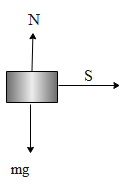
Calculate the work done against gravity by a coolie in carrying a load of mass 10kg in his head when he walks uniformly a distance of 5m in the (1) horizontal direction (2) vertical direction. (Take g=10m/s)
(A) 0,500
(B) 500,0
(C ) 250,250
(D) 400, 100
Answer
557.4k+ views
Hint: Work done is the dot product of force and distance. Here the applied force is normal which is equal to the product of mass and gravity. The angle between them in horizontal direction is 90 degrees and angle between them in vertical direction is 0 degrees. By substituting the values of the magnitude of displacement and force and the cosine of angle we will get the work done in horizontal and vertical direction.
Formula used:
The work done, $W=F.S$
where, F is the normal force
S is the distance.
$\Rightarrow W=FS\cos \theta $
Complete step-by-step answer:
(i) When S is in horizontal direction.

Work done is described as the dot product of force and displacement. Then the work done is,
$W=F.S$
where, F is the normal force
S is the distance.
$\Rightarrow W=FS\cos \theta $
Here the force is normal. Hence it is equal to the product of mass and gravity.
$F=N=mg$
Given that,
S=5m
$\theta ={{90}^{\circ }}$
So, $W=FS\cos \theta $ ………..(1)
Then calculate the magnitude of force. That is,
$\begin{align}
& F=mg \\
& \Rightarrow F=10\times 10 \\
& \therefore F=100N \\
\end{align}$
Also given that, S=5m
Then by substituting the values in the equation (1) we get,
$\Rightarrow W=100\times 5\times \cos {{90}^{\circ }}$
$\therefore W=0J$
Hence, the work done is zero joule when the man walks in the horizontal direction.
(ii) When it is in vertical direction,

The work done, $W=F.S$
$\Rightarrow W=FS\cos \theta $
$\theta ={{0}^{\circ }}$
Hence, $W=FS\cos \theta $
Then substituting the values we get,
$\Rightarrow W=100\times 5\times \cos {{0}^{\circ }}$
$\therefore W=500J$
Thus the work done is 500 joules while the man is travelling in the vertical direction.
So, the correct answer is “Option A”.
Note: Thus the work done is described as the dot product of force and displacement. Then by expanding them we get that the work done is the product of force, displacement and the cosine of the angle between them. Here the applied force is normal which is equal to the product of mass and gravity. The angle between them in horizontal direction is 90 degrees and angle between them in vertical direction is 0 degrees. Thus at vertical direction work done becomes zero.
Formula used:
The work done, $W=F.S$
where, F is the normal force
S is the distance.
$\Rightarrow W=FS\cos \theta $
Complete step-by-step answer:
(i) When S is in horizontal direction.

Work done is described as the dot product of force and displacement. Then the work done is,
$W=F.S$
where, F is the normal force
S is the distance.
$\Rightarrow W=FS\cos \theta $
Here the force is normal. Hence it is equal to the product of mass and gravity.
$F=N=mg$
Given that,
S=5m
$\theta ={{90}^{\circ }}$
So, $W=FS\cos \theta $ ………..(1)
Then calculate the magnitude of force. That is,
$\begin{align}
& F=mg \\
& \Rightarrow F=10\times 10 \\
& \therefore F=100N \\
\end{align}$
Also given that, S=5m
Then by substituting the values in the equation (1) we get,
$\Rightarrow W=100\times 5\times \cos {{90}^{\circ }}$
$\therefore W=0J$
Hence, the work done is zero joule when the man walks in the horizontal direction.
(ii) When it is in vertical direction,

The work done, $W=F.S$
$\Rightarrow W=FS\cos \theta $
$\theta ={{0}^{\circ }}$
Hence, $W=FS\cos \theta $
Then substituting the values we get,
$\Rightarrow W=100\times 5\times \cos {{0}^{\circ }}$
$\therefore W=500J$
Thus the work done is 500 joules while the man is travelling in the vertical direction.
So, the correct answer is “Option A”.
Note: Thus the work done is described as the dot product of force and displacement. Then by expanding them we get that the work done is the product of force, displacement and the cosine of the angle between them. Here the applied force is normal which is equal to the product of mass and gravity. The angle between them in horizontal direction is 90 degrees and angle between them in vertical direction is 0 degrees. Thus at vertical direction work done becomes zero.
Recently Updated Pages
Why are manures considered better than fertilizers class 11 biology CBSE

Find the coordinates of the midpoint of the line segment class 11 maths CBSE

Distinguish between static friction limiting friction class 11 physics CBSE

The Chairman of the constituent Assembly was A Jawaharlal class 11 social science CBSE

The first National Commission on Labour NCL submitted class 11 social science CBSE

Number of all subshell of n + l 7 is A 4 B 5 C 6 D class 11 chemistry CBSE

Trending doubts
What is meant by exothermic and endothermic reactions class 11 chemistry CBSE

10 examples of friction in our daily life

One Metric ton is equal to kg A 10000 B 1000 C 100 class 11 physics CBSE

1 Quintal is equal to a 110 kg b 10 kg c 100kg d 1000 class 11 physics CBSE

Difference Between Prokaryotic Cells and Eukaryotic Cells

What are Quantum numbers Explain the quantum number class 11 chemistry CBSE




